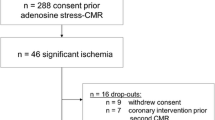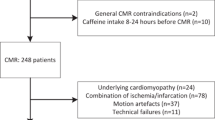Abstract
Objectives
This prospective study investigated the effects of caffeine ingestion on the extent of adenosine-induced perfusion abnormalities during myocardial perfusion imaging (MPI).
Methods
Thirty patients with inducible perfusion abnormalities on standard (caffeine-abstinent) adenosine MPI underwent repeat testing with supplementary coffee intake. Baseline and test MPIs were assessed for stress percent defect, rest percent defect, and percent defect reversibility. Plasma levels of caffeine and metabolites were assessed on both occasions and correlated with MPI findings.
Results
Despite significant increases in caffeine [mean difference 3,106 μg/L (95% CI 2,460 to 3,752 μg/L; P < .001)] and metabolite concentrations over a wide range, there was no statistically significant change in stress percent defect and percent defect reversibility between the baseline and test scans. The increase in caffeine concentration between the baseline and the test phases did not affect percent defect reversibility (average change −0.003 for every 100 μg/L increase; 95% CI −0.17 to 0.16; P = .97).
Conclusion
There was no significant relationship between the extent of adenosine-induced coronary flow heterogeneity and the serum concentration of caffeine or its principal metabolites. Hence, the stringent requirements for prolonged abstinence from caffeine before adenosine MPI—based on limited studies—appear ill-founded.



Similar content being viewed by others
References
Henzlova MJ, Cerqueira MD, Hansen CL, Taillefer R, Yao S-S. ASNC imaging guidelines for nuclear cardiology procedures: Stress protocols and tracers. J Nucl Cardiol 2009. doi:10.1007/s12350-009-9062-4.
Nishimura S, Mahmarian JJ, Boyce TM, Verani MS. Equivalence between adenosine and exercise thallium-201 myocardial tomography: A multicenter, prospective, crossover trial. J Am Coll Cardiol 1992;20:265-75.
Daly JW, Hide I, Muller CE, Shamim M. Caffeine analogs: Structure-activity relationships at adenosine receptors. Pharmacology 1991;42:309-21.
Miyamoto MI, Vernotico SL, Majmundar H, Thomas GS. Pharmacologic stress myocardial perfusion imaging: A practical approach. J Nucl Cardiol 2007;14:250-5.
Hesse B, Tagil K, Cuocolo A, Anagnostopoulos C, Bardies M, Bax J, et al. EANM/ESC procedural guidelines for myocardial perfusion imaging in nuclear cardiology. Eur J Nucl Med Mol Imaging 2005;32:855-97.
Smits P, Aengevaeren WR, Corstens FH, Thien T. Caffeine reduces dipyridamole-induced myocardial ischemia. J Nucl Med 1989;30:1723-6.
Smits P, Corstens FH, Aengevaeren WR, Wackers FJ, Thien T. False-negative dipyridamole-thallium-201 myocardial imaging after caffeine infusion. J Nucl Med 1991;32:1538-41.
Zoghbi GJ, Htay T, Aqel R, Blackmon L, Heo J, Iskandrian AE. Effect of caffeine on ischemia detection by adenosine single photon emission computed tomography perfusion imaging. J Am Coll Cardiol 2006;47:2296-302.
Reyes E, Loong CY, Harbinson M, Donovan J, Anagnostopoulos C, Underwood SR. High-dose adenosine overcomes the attenuation of myocardial perfusion reserve caused by caffeine. J Am Coll Cardiol 2008;52:2008-16.
Lapeyre AC III, Goraya TY, Johnston DL, Gibbons RJ. The impact of caffeine on vasodilator stress perfusion studies. J Nucl Cardiol 2004;11:506-11.
Kroon LA. Drug interactions with smoking. Am J Health Syst Pharm 2007;64:1917-21.
Butler MA, Iwasaki M, Guengerich FP, Kadluber FF. Human cytochrome P-450PA (P-450IA2), the phenacetin O-deethylase, is primarily responsible for the hepatic 3-demethylation of caffeine and N-oxidation of carcinogenic arylamines. Proc Natl Acad Sci USA 1989;86:7696-700.
Cerqueira MD, Weissman NJ, Dilsizian V, Jacobs AK, Kaul S, Laskey WK, et al. Standardized myocardial segmentation and nomenclature for tomographic imaging of the heart: A statement for healthcare professionals from the Cardiac Imaging Committee of the Council on Clinical Cardiology of the American Heart Association. J Nucl Cardiol 2002;9:240-5.
Liguori A, Hughes JR, Grass JA. Absorption and subjective effects of caffeine from coffee, cola and capsules. Pharmacol Biochem Behav 1997;58:721-6.
Stewart NA, Buch SC, Conrads TP, Branch RA. A UPLC-MS/MS assay of the “Pittsburgh cocktail”: Six CYP probe-drug/metabolites from human plasma and urine using stable isotope dilution. Analyst 2011;7:505-12.
Xu Y, Hayes S, Ali I, Ruddy TD, Wells RG, Berman DS, et al. Automatic and visual reproducibility of perfusion and function measures for myocardial perfusion SPECT. J Nucl Cardiol 2010;17:1050-7.
Berman DS, Germano G. Interpretation and reporting of gated myocardial perfusion SPECT. In: Germano G, Berman DS, editors. Clinical gated cardiac SPECT 2nd ed. Oxford: Blackwell Publishing; 2006. p 139-71.
Barnett AG, van der Pols J, Dobson AJ. Regression to the mean: What it is and how to deal with it. Int J Epidemiol 2005;34:215-20.
Salcedo J, Kern MJ. Effects of caffeine and theophylline on coronary hyperemia induced by adenosine or dipyridamole. Catheter Cardiovasc Interv 2009;74:598-605.
Aqel RA, Zoghbi GJ, Trimm JR, Baldwin SA, Iskandrian AE. Effect of caffeine administered intravenously on intracoronary-administered adenosine-induced coronary hemodynamics in patients with coronary artery disease. Am J Cardiol 2004;93:343-6.
Bottcher M, Czernin J, Sun KT, Phelps ME, Schelbert HR. Effect of caffeine on myocardial blood flow at rest and during pharmacological vasodilation. J Nucl Med 1995;36:2016-21.
Kubo S, Tadamura E, Toyoda H, Mamede M, Yamamuro M, Magata Y, et al. Effect of caffeine intake on myocardial hyperemic flow induced by adenosine triphosphate and dipyridamole. J Nucl Med 2004;45:730-8.
Namdar M, Koepfi P, Grathwohl R, Siegrist PT, Klainguti M, Schepis T, et al. Caffeine decreases exercise-induced myocardial flow reserve. J Am Coll Cardiol 2006;47:405-10.
Stanek EJ, Melko GP, Charland SL. Xanthine interference with dipyridamole-thallium-201 myocardial imaging. Ann Pharmacother 1995;29:425-7.
Heller G, Dweik R, Barbour M, Garber CE, Cloutier DJ, Messinger DE, et al. Pretreatment with theophylline does not affect adenosine-induced thallium-201 myocardial imaging. Am Heart J 1993;126:1077-83.
Hurwitz R, Lyons K, Taketa R. Adenosine challenge and boost protocols: New tools for myocardial perfusion imaging. Clin Nucl Med 1999;24:92-3.
Majd-Ardekani J, Clowes P, Menash-Bonsu V, Nunan TO. Time for abstention from caffeine before an adenosine myocardial perfusion scan. Nucl Med Commun 2000;21:361-4.
Barone JJ, Roberts HR. Caffeine consumption. Food Chem Toxicol 1996;34:119-29.
McCusker RR, Goldberger BA, Cone EJ. Caffeine content of specialty coffees. J Anal Toxicol 2003;27:520-2.
McCusker RR, Goldberger BA, Cone EJ. Caffeine content of energy drinks, carbonated sodas, and other beverages. J Anal Toxicol 2006;30:112-4.
Kovacs D, Pivonka R, Khosla PG, Khosla S. Effect of caffeine on myocardial perfusion imaging using single photon emission computed tomography during adenosine pharmacologic stress. Am J Ther 2008;15:431-4.
Balogh A, Harder S, Vollandt R, Staib AH. Intra-individual variability of caffeine elimination in healthy subjects. Int J Clin Pharmacol Ther Toxicol 1992;30:383-7. [published erratum appears in Int J Clin Pharmacol Ther Toxicol 1993;31:208].
Tiffin P, Ashton H, Marsh R, Kamali F. Pharmacokinetic and pharmacodynamic responses to caffeine in poor and normal sleepers. Psychopharmacology 1995;121:494-502.
Mahmarian JJ, Cerqueira MD, Iskandrian AE, Bateman TM, Thomas GS, Hendel RC, et al. Regadenoson induces comparable left ventricular perfusion effects as adenosine: A quantitative analysis from the ADVANCE MPI 2 trial. J Am Coll Cardiol Imaging 2009;2:959-68.
Lande RG, Latbatte LA. Caffeine use and plasma concentrations in psychiatric outpatients. Depress Anxiety 1998;7:130-3.
Iskandrian AE, Bateman TM, Belardinelli L, Blackburn B, Cerqueira MD, Hendel RC, et al. Adenosine versus regadenoson comparative evaluation in myocardial perfusion imaging: Results of the ADVANCE phase 3 multicenter international trial. J Nucl Cardiol 2007;14:645-58.
Cerqueira MD, Nguyen P, Staehr P, Underwood SR, Iskandrian AE. Effects of age, gender, obesity, and diabetes on the efficacy and safety of the selective A2A agonist regadenoson versus adenosine in myocardial perfusion imaging. J Am Coll Cardiol Imaging 2008;1:307-16.
Tejani F, Thompson RC, Iskandrian AE, McNutt BE, Franks B. Effect of caffeine on SPECT myocardial perfusion imaging during regadenoson pharmacologic stress: Rational and design of a prospective, randomized, multicentre study. J Nucl Cardiol 2011;18:73-81.
Acknowledgments
The authors are grateful for the assistance of the following colleagues: Dr Scarlett Lewitschnig, Dr Reza Garzan and Philip Stuart RN (Department of Nuclear Medicine), Dr Mark Whitby (Biomedical Technology Services) and Dr Anita Green and Dr Peta Margrie (Cardiology Program).
Conflicts of interest
The authors have indicated that they have no financial conflicts of interest.
Author information
Authors and Affiliations
Corresponding author
Additional information
Grants/funding: The Prince Charles Hospital Private Practice Trust Fund.
See related Editorial in this issue by Drs. Hage and Iskandrian. Readers online can view the Editorial at doi:10.1007/s12350-012-9519-8.
Rights and permissions
About this article
Cite this article
Lee, J.C., Fraser, J.F., Barnett, A.G. et al. Effect of caffeine on adenosine-induced reversible perfusion defects assessed by automated analysis. J. Nucl. Cardiol. 19, 474–481 (2012). https://doi.org/10.1007/s12350-012-9517-x
Received:
Accepted:
Published:
Issue Date:
DOI: https://doi.org/10.1007/s12350-012-9517-x




